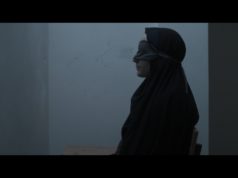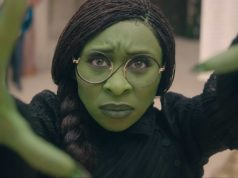You’ll note that no documentaries made my list of Top 10 movies this year, but that’s not because this was a bad year for docs. On the contrary, I saw a bunch of great nonfiction films this year, but I found myself at a loss this year about how to rate them against the fiction films, and wound up settling for listing two in my honorable mention. Here’s my chance to go into greater detail:
1. Project Nim
When Noam Chomsky proclaimed in the 1970s that language was what separated human intelligence from animal, a group of Columbia researchers set out to prove him wrong by teaching sign language to a baby chimp, which they named Nim Chimpsky. This set off the tragic chain of events chronicled in James Marsh’s searing film, which interviews researchers involved with Project Nim. The project fell victim to human frailties of infighting and sexual jealousy (telling that the professor running the project hired a bunch of researchers who were all attractive young women), and the monkey wound up paying for all their mistakes. You don’t have to be an animal lover to be sickened by the multiple cruel fates in store for poor Nim, and it’s crueler still that they were inflicted mostly by people who loved him and wanted the best for him. This movie brings home a good truth to keep in mind: Animals are not people. Pair this up with Rise of the Planet of the Apes for a stimulating double bill.

2. Cave of Forgotten Dreams
Even without the 3D projection that it enjoyed in theaters, Werner Herzog’s film is breathtaking stuff. The German filmmaker travels to the Chauvet Cave in southern France, where the earliest known cave paintings (some 20,000 years old) were recently discovered. His interviews with the paleontologists, archeologists, spelunkers, and art historians who are among the few experts allowed into the site would be spellbinding in themselves, but Herzog takes the opportunity to speculate about what the people who painted those pictures were like and what they might have thought. You already know that Herzog does awestruck wonder as well as anyone, but here his subject matches his capabilities.

3. Buck
I already went into some detail in my review of the film, but this is yet another work that could pair well with Project Nim, one that advocates understanding animals as animals and not as extensions of ourselves. Cindy Meehl’s documentary not only gets the horses right (it’s far better than War Horse on that score), but sketches in a sensitive, layered, and often funny portrait of its subject, Buck Brannaman, a cowboy who has emerged from a terrible childhood to become a gentle and effective handler of horses. Bonus points for the star power here, as Meehl also scores an interview with Robert Redford, who worked with Brannaman on the set of The Horse Whisperer.

4. Senna
Even those with zero interest in auto racing will still likely be engrossed by Asif Kapadia’s portrait of Ayrton Senna, the Brazilian F1 racing legend whose meteoric career lit up the sports pages in the 1980s and ‘90s. Senna’s ongoing rivalry with French driver and temperamental opposite Alain Prost gives the drama Shakespearean amplitude, but between Senna’s ecstatic screams of joy after first winning the Brazilian Grand Prix (after he’d already won almost every honor in his sport) and the grief brought about by his death (testified to by an untranslated clip of a tearful Japanese news crew at the scene of his fatal wreck), no other documentary this year offers such a range of emotion.

5. El Bulli: Cooking in Progress
I predicted this movie would make this list two months ago. I’ll admit that part of the reason I have this ranked so high is that I’m fascinated by molecular gastronomy and the avant-garde cuisine put forth by Ferran Adrià. Yet Gereon Wetzel’s documentary is intrinsically worth seeing for the near-mystical reverence with which it observes the goings-on at Adrià’s fabled Catalonian restaurant. I’m sad that I saw this film without ever getting the chance to dine at El Bulli and then write badly about the experience, but this film is a nice souvenir.

6. The Arbor
The most formally adventurous item on this list, Clio Barnard’s film profiles the family of Andrea Dunbar, the British playwright who made headlines at age 15 when she won a playwriting contest with a stage piece about her life in a poverty-stricken housing project (the British call it “council housing”). The audio is of interviews with Dunbar’s grown children and people who knew her, but the people who appear on screen are actors lip-syncing to the words. These are mixed in with actors performing scenes from Dunbar’s play The Arbor, staged on a lawn at the Yorkshire council estate where Dunbar grew up. The distancing devices help mitigate the unrelieved misery of Dunbar’s short life (she wasted her early talent and died of a brain aneurysm at age 29) and the vices that she passed down to her children.

7. The Interrupters
I feel bad placing a work of such social significance this low on the list, but Steve James’ documentary didn’t engage me emotionally the way his legendary 1994 film Hoop Dreams did. No matter; this is still an important piece of cinema, chronicling the work of CeaseFire, the organization of former Chicago gang members that treats crime like an infectious disease and uses non-violent methods to settle disputes and prevent crime in the city’s housing projects. For anyone who has looked at the seemingly intractable problems of poverty and violence, this film and the unorthodox methods depicted in it provide some hope.

8. We Were Here
David Weissman and Bill Weber’s deeply moving elegy to the victims of AIDS pays tribute to those victims by interviewing five survivors of the epidemic who witnessed firsthand the devastation wrought in San Francisco during the 1980s. As much as it deals with the many thousands cut down in their youth by the disease, this documentary also takes in the resiliency of the survivors and their views on a world that’s markedly different from the one they grew up in.

9. Beats, Rhymes & Life: The Travels of A Tribe Called Quest
I hope you like rap songs, Bonita Applebum. As I said in my earlier review, Michael Rapaport’s documentary not only details the impact that this seminal rap group of the 1990s had on the music scene but also draws portraits of the very different men behind the group and the shared long-term friendship that flayed them and inspired them to make some of the best hip-hop ever. It’s a splashy and entertaining piece with appearances by a lot of music stars, but it’s got depth and complexity on its side, too.

10. If a Tree Falls: A Story of the Earth Liberation Front
Marshall Curry’s documentary began when the shelter for abused women that his wife ran was visited by the FBI, who arrested one of her domestic violence counselors as a fugitive eco-terrorist. No one disputes that Daniel McGowan planned the firebombing of two lumber companies cutting down trees in the Pacific Northwest. Why the government is bracketing him with Osama bin Laden when his crimes produced no human casualties is a different matter. The film is shot through with the burned-out idealism of misguided environmentalists who thought they could save the Earth with a few bombings.

Honorable mention: Andrew Rossi’s Page One: Inside the New York Times, Errol Morris’ Tabloid, Peter Wiedensmith’s Raw Faith, Robert Cibis and Lilian Franck’s Pianomania, Aaron Schock’s Circo, Crayton Robey’s Making the Boys.











